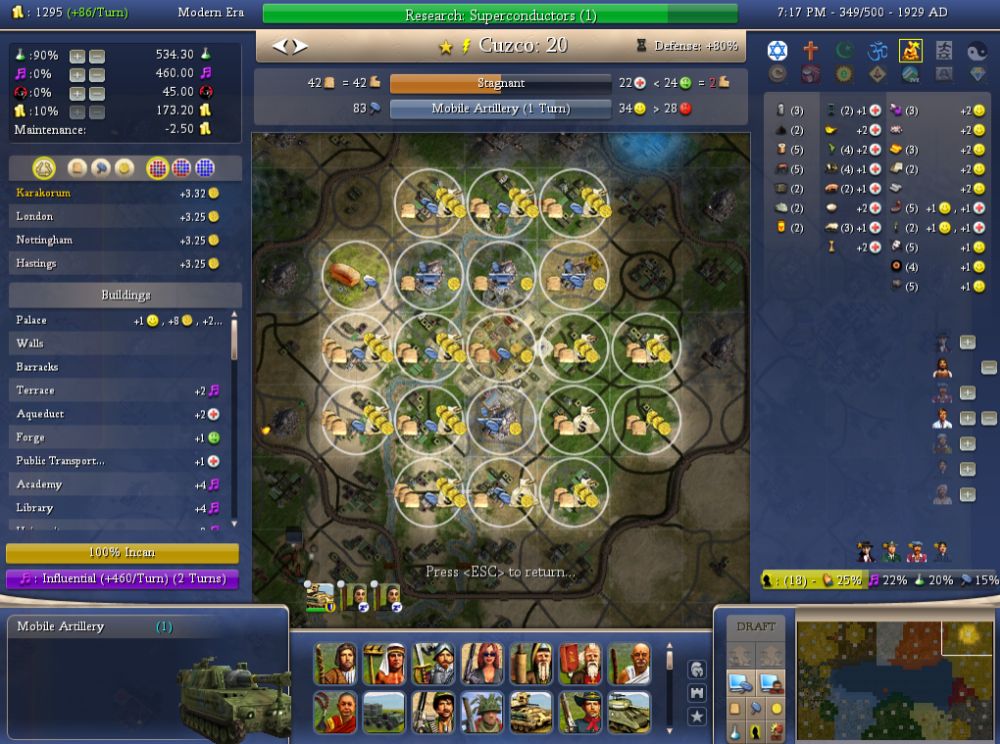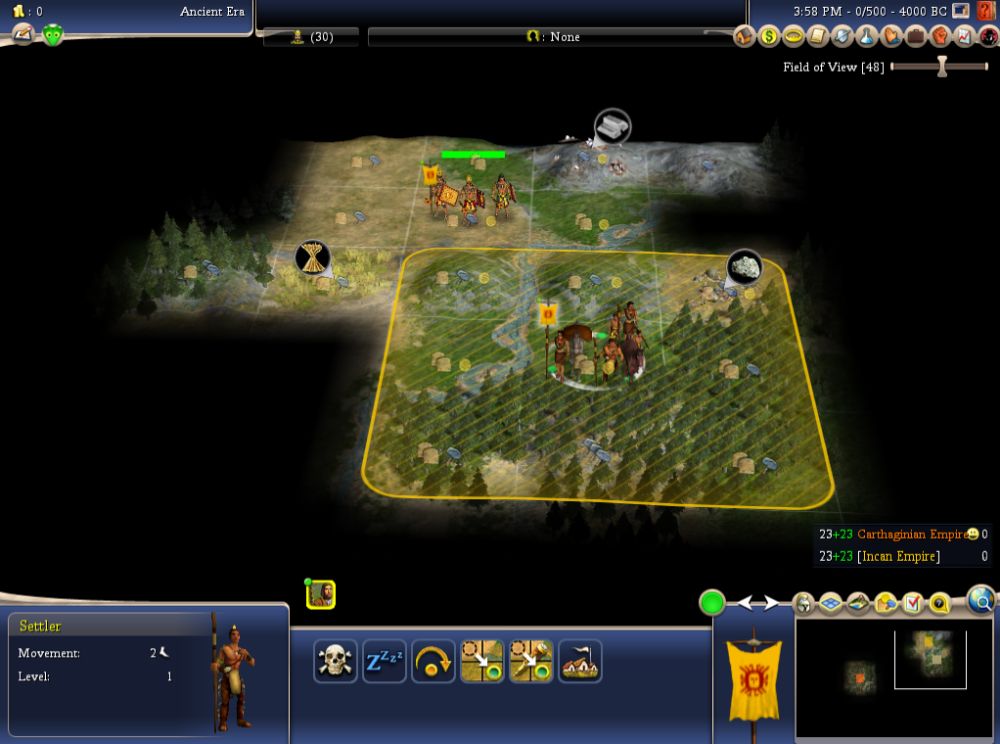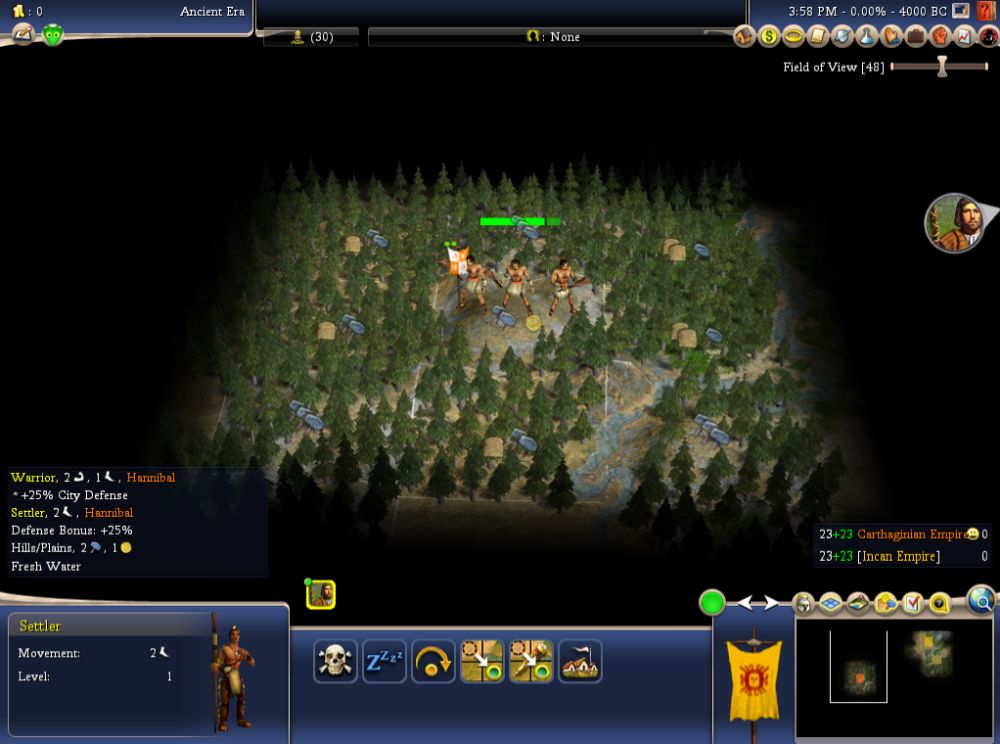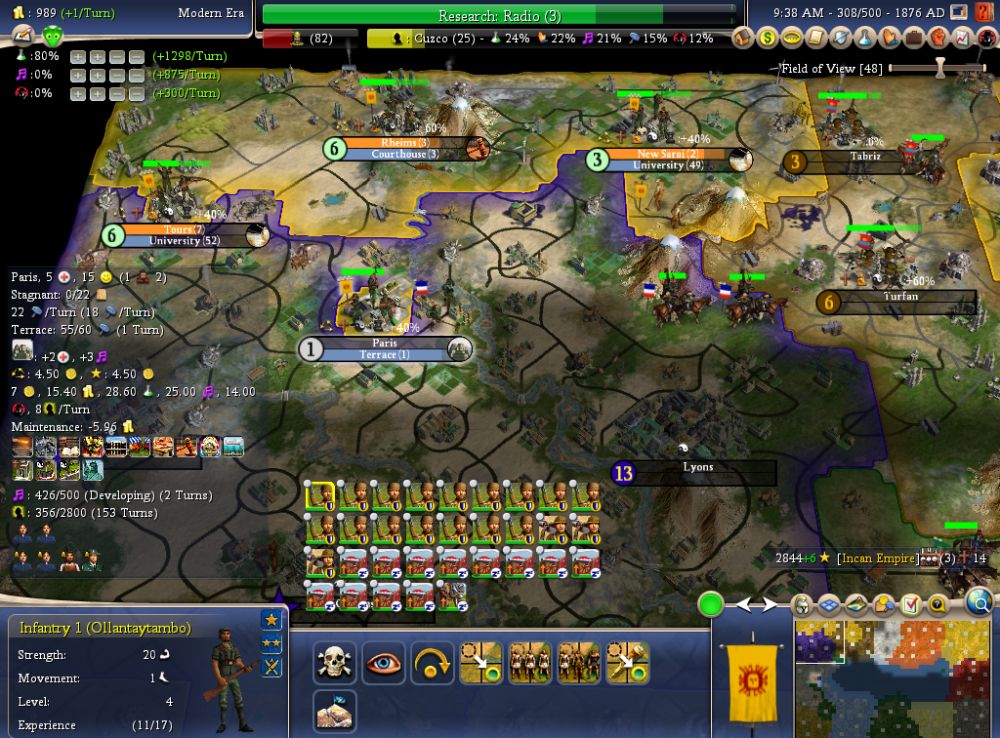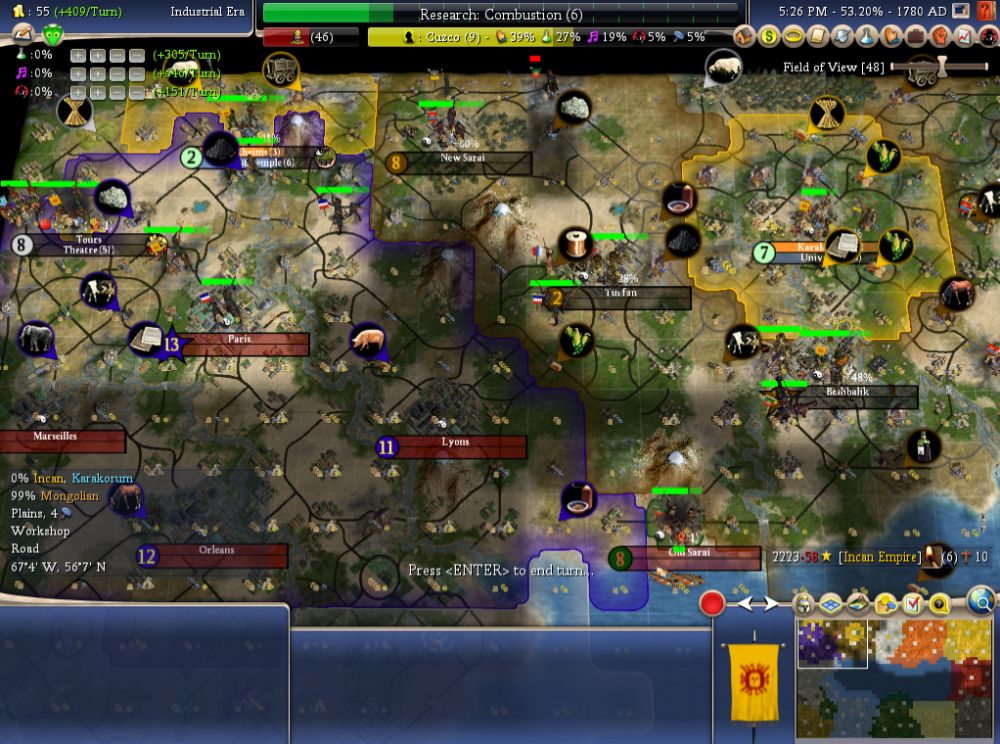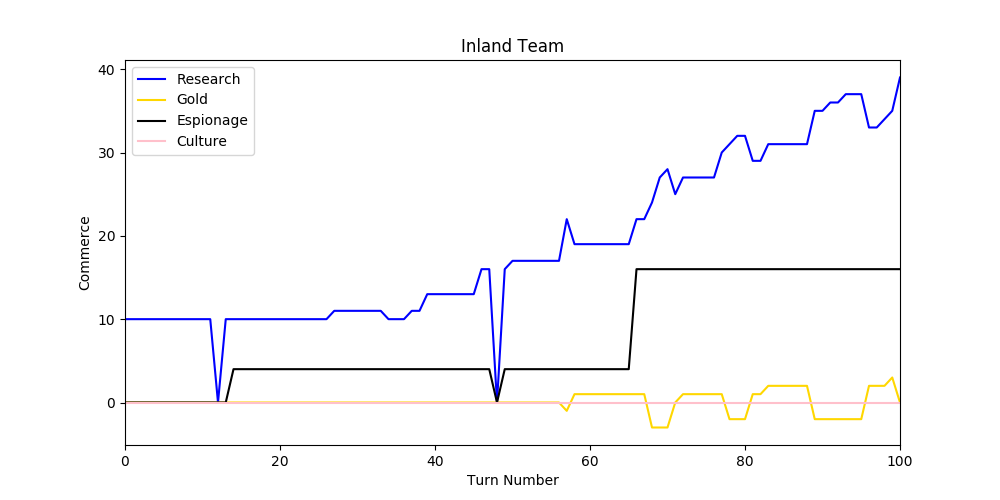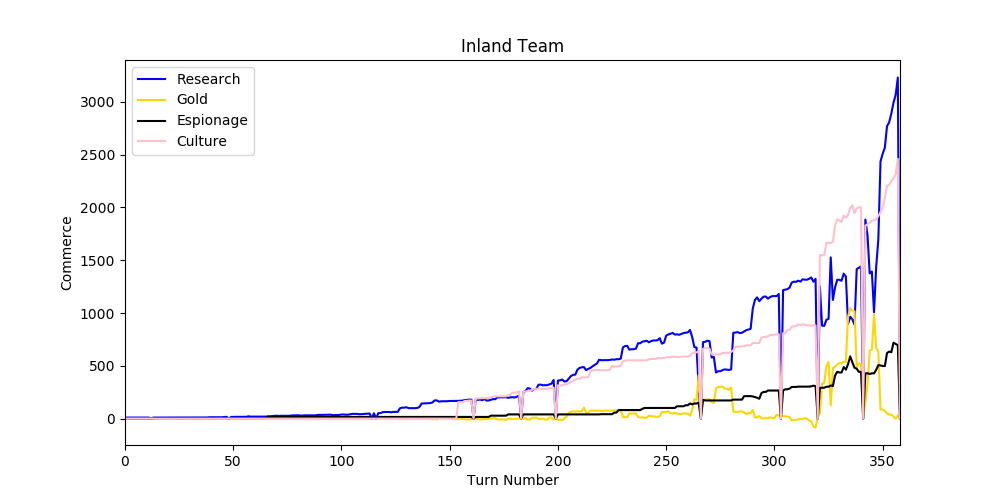Map Settings
Team Play
- Team 1
- Human Player: Huayna Capac of the Incans
- Computer AI teammate: Hannibal of Carthage
- Team 2
- Team 3
- Team 4
- Team 5
- Team 6
- Team 7
Options
- Noble Difficulty,
- No Barbarians,
- because I don't like them.
- Choose Religions,
- because I like the Buddhism icon better than the Hindu one, but I want to research Polytheism first, so I can research Monotheism second.
- No Technology Brokering,
- so I don't have to worry (too much) about Hannibal making bad tech trades on my behalf.
- No Tribal Villages,
- since I never make scouting a priority, the AI always beats me to those Goodie Huts.
- No Random Events
- because they skew the results; and to be honest, I think most of the events should be perpetually on and available for any team that completes the requirements first; but they are not, so farewell.
All Victory Conditions
Mod Settings
- Beyond the Sword 3.19
- BUG Mod 4.5 [Build 2221]
- BULL 1.4 [Build 243]
- BAT Mod 4.1
Planned Strategies
Quechua Rush
With Wheat in my Fat Cross and Agriculture already researched, I will first build a Worker; and then, pump out a half dozen or so Quechuas in a bid to take over a rival Civilization's capitol. If it works well enough, I may try taking out two Civilizations. But I doubt I will be that efficient.
Religious Power House
At the same time, I intend to hi-jack Hannibal's research (by telling him what to research; and then, having him switch out at the last minute), so I found two of the starting Religions in my capitol (via Polytheism and Monotheism). After that, I intend to let the Carthagians research what they will... until it is time to hi-jack them again.
Wonder Crazy
Lastly, I expect part of the fun of this game to be in going completely and utterly Wonder Crazy in my capitol. We'll see how that goes. As crowded as we are (twelve civilizations on a standard size map), there may be more pressing concerns.
Planned Strategy Debriefing
Quechua Rush
This failed miserably. I sent a half dozen Quechua's against a lone fortified archer (probably on a hilltop) and lost all my troops. At which point, I restarted the game. Clearly, this strategy is not for me.
Religious Powerhouse
At this point, I'd have to load the game to remember how many religions I founded. But best guess, it was only the one (or two). And that did not make much game play difference. I mean, having the Holy Shrine, paid off in gold. But I wound up switching to Catherine of Russia's religion to avoid a Holy War. So, it's not like my religion became the dominant religion on the board.
Wonder Crazy
I enjoy building Wonders. And as I was playing this on Noble, I was able to build over half the Wonders. It was fun. I question how much they aided in winning the game. I mean, they certainly helped making my Civilization technologically dominant. But once I was (technologically dominant), war was the road to victory.
The Formula
Cities get more culture every turn. And it is pretty straightforward to determine a City's culture, simply hover the mouse over a City's Name Bar. And this will show both the City's Total Culture and the additional Culture Per Turn (CPT) it is receiving.
All plots on the game board have culture as well. For every plot that a City influences, that plot gets two cultural values added to it (each and every turn).
+ CPT
+ 20 * Extra_Size
Where CPT is the Influencing City's Culture Per Turn.
This Extra Size notion (on the other hand) is not so easy to put into words (even if it is a fairly simple concept). But this is where almost all the Plot Culture in the game comes from, so it's good to understand.
Here's the City Cultural Size Chart.
S Minimum Name
1 0 Poor
2 10 Fledgling
3 100 Developing
4 500 Refined
5 5,000 Influential
6 50,000 Legendary
Where:
S is the Size or Influence Level of a City
Minimum is the Minimum Culture a City must have to obtain this size
And, Name is what this level of Influence is called.
A City's Influence stretches outward one square for each Influence Level it has. So, at the start, a City is at Influence Level 1 and only has Influence over the surrounding nine tiles. Whereas, at Influence Level Six (the highest), the Influence stretches out for six squares.
Extra Size is how many sizes more than it needs to reach a given Plot Tile a given City has.
So, a Size 6 City, with CPT=10, adds 110 point of Plot Tile Culture to every Tile that is one square away every turn.
CPT + (20 * ExtraSize)
10 + (20 * (6 - 1))
10 + (20 * 5)
10 + 100
110
Every City adds Culture to every Plot within its Influence every turn. So, any given Plot's Culture may be Influenced by multiple Friendly Cities and a divergent array of Enemy Cities each and every turn.
Of the Civilizations that control a City that exerts Cultural Influence over a Plot the Civilization that has the most Plot Culture in that Plot controls that Plot.
Eh, it's a lot of words.
So, two conditions:
- A Civilization must have a nearby City
- That Civilization must have the most Culture in the Plot (than any other Civilization) with a nearby City.
The Long View
So, why is Paris surrounded by French controlled tiles? Because France still controls Lyons (and that other City, blocked out to the left); and so, a French City still reaches those tiles. But even worse than that, Lyons (and that other City, blocked out to the left) still continue to add culture to all those Plot Tiles.
And although gaining control of those Plot Tiles is just a matter of exerting enough Influence, in many instances that will never happen.
Which is to say, it can be quite the hopeless battle to fight a Culture War against a well entrenched Civilization.
Note, the following tables are not to be studied (in my opinion, anyway). But rather, are simply to give a vague idea as to the nature of the situation.
A Simple City (CPT=2)
The City starts with two culture per turn (say, as from the Creative Leadership Trait) and no additional cultural improvements are made. Thus, at Turn 50, the City is producing two culture per turn, and Plot Tiles one square away (i.e. those next to the City) have an even thousand culture in them, those two Plot Tiles away have ninety, and there is no culture in those any further away (from this City).
| Turn | CPT | R1 | R2 | R3 |
| 50 | 2 | 1000 | 90 | 0 |
| 100 | 2 | 3100 | 1190 | 100 |
| 250 | 2 | 9400 | 4490 | 400 |
| 500 | 2 | 24900 | 14990 | 5900 |
Culturally Improving City (CPT=2 +2/50Turns)
A City that starts at CPT=2, but builds a cultural improvement worth +2CPT every fifty turns. Note, the results shown in these tables should maybe be shifted by a single turn, as I don't know exactly when (whether it is at the beginning or the end of the turn) Cultural Influence is calculated (or even what comes first, Culture or the Build Queue). Or in other words, at Turn 51 (not shown), the CPT is 4.
| Turn | CPT | R1 | R2 | R3 |
| 50 | 2 | 1000 | 90 | 0 |
| 100 | 4 | 3200 | 1290 | 200 |
| 250 | 10 | 12,720 | 7,810 | 3720 |
| 500 | 20 | 32,220 | 22,310 | 13,220 |
Please Note: The tables above track a different number of turns than the tables below.
Captured City Fighting Cultural Battle (CPT=0 +2/5Turns)
A theoretically captured City that is producing a new culture building worth two additional culture every five turns.
| Turn | CPT | R1 | R2 | R3 |
| 5 | 0 | 0 | 0 | 0 |
| 10 | 2 | 10 | 0 | 0 |
| 25 | 8 | 400 | 90 | 0 |
| 50 | 18 | 1750 | 940 | 350 |
| 100 | 38 | 6140 | 4330 | 2740 |
Captured City with Heightened Temple (CPT=14)
In this game, due to Wonders and Civics, a Christian Temple was worth fourteen culture per turn. So, building a lone Temple was as good as cranking out a slew of lesser cultural improvements.
| Turn | CPT | R1 | R2 | R3 |
| 5 | 14 | 150 | 56 | 0 |
| 10 | 14 | 360 | 166 | 28 |
| 25 | 14 | 1170 | 676 | 238 |
| 50 | 14 | 2800 | 1806 | 868 |
| 100 | 14 | 6500 | 4506 | 2568 |
Cultural Temple Powerhouse
+1 CPT for City with State Religion
+1 CPT for State Religion Temple
+5 CPT for Sistine Chapel
+100% for Free Speech
14 Culture Per Turn
In Summary
The main takeaway (for me, anyhow) is that a Creative Type gets all the advantages of a mid-level cultural builder right out of the gate. And even at such a low level of cultural output, exerting control over the surrounding countryside of a newly captured City may well prove nigh impossible (you know, as long as another City's Cultural Influence extends to the Plot in question).
And a few key Buildings (say, a Christian Temple with the appropriate Wonders and Civics) can outperform a bevy of lesser improvements.
In the end, the formulas don't really matter to me.
Some opponents will prioritize culture; and so, winning a cultural war against them will not be possible. While other will not; and thus, pushing back their borders with culture will be possible.
Culture Flipping
If a City is controlled by one Civilization but the underlying Plot is controlled by another (and the City in question was not captured by the one from other in the first place, as there are no flip-backs) there is a (small) chance (every turn) that the City will Revolt and offer to switch sides. The first Revolt always fails. And the formula for Revolt is complicated enough I cannot be bothered to try and understand it. Suffice to say, garrison troops help to prevent a Revolt. But taking over any nearby Cities that have any Cultural Influence, which extends to the City in question, will likely work better in the long run. Just saying.
These are the same graphs, as I developed in the last post. Spikes to zero are from Revolutions (from changing Civics). Also note, the increase in Research (and less so, in Culture) over time. I am convinced that Research Speed is linked to Victory. So, I will be concentrating on it from now on.
Also, one last image of my capitol before I sign off. It is both a Research and Cultural powerhouse.
